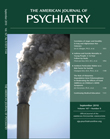Mania in a Patient With H1N1: Is Oseltamivir the Culprit or a Red Herring?
To the Editor: In the March 2010 issue of the Journal, Lily N.L. Ho, M.B.Ch.B., et al. (1) reported on a case of an 18-year-old woman who developed symptoms of mania after the first day of a 5-day course of oseltamivir for influenza A (H1N1). However, the patient's history indicated that oseltamivir may have been a red herring in the causation of mania. Although symptoms of mania started after the first day of treatment with oseltamivir, they did not subside until 30 days after discontinuation, despite treatment with a high-dose antipsychotic and mood stabilizer. This is unlike many drug-induced psychosis cases, where symptoms subside soon after the withdrawal of the offending drug (2).
A more likely explanation for mania in this case is the combination of influenza and high fever (39.4° C) in an individual at high risk for bipolar disorder (a positive family history) and at an age close to the mean age of onset of the illness. Viral infections have been widely reported to be associated with mood disorders (3), and influenza has been associated with both depression and mania (4, 5).
As part of collaboration between the National Centre for Immunisation Research and Surveillance and the Australian Paediatric Surveillance Unit, in 2009 we studied 226 consecutive hospital admissions of children aged <15 years with laboratory confirmed influenza (86% H1N1). In total, nearly one-half (46.5%) of those with confirmed influenza were treated with oseltamivir. None of the patients developed any neuropsychiatric adverse events following treatment. In three cases (1.3%), confusion was part of the presenting symptoms of influenza. One of these cases was treated with oseltamivir for 5 days without any exacerbation of the confusion.
Ho et al. suggested that Chinese or Japanese ancestry may be related to developing neuropsychiatric adverse events of oseltamivir. However, this is unlikely, since no clinically relevant differences in the plasma pharmacokinetics of oseltamivir and its active metabolite oseltamivir carboxylate have been noted between Japanese and Caucasian adults or children (6). Moreover, there is evidence to suggest that neuropsychiatric adverse events in Japanese children with influenza occurred before starting oseltamivir, and these events were similar to those occurring after treatment. This is consistent with previous findings that influenza itself is associated with higher risk of neuropsychiatric events. Analysis of medical records in the United Kingdom General Practice Research Database showed significantly higher adjusted relative risk (1.75) of such symptoms in influenza patients than in the general population, an analysis performed when antivirals were seldom used (6). Therefore, general practitioners and psychiatrists should be watchful for psychiatric complications following influenza and other viral infections, particularly in predisposed individuals.
1. : Oseltamivir-induced mania in a patient with H1N1. Am J Psychiatry 2010; 167:350Link, Google Scholar
2. : Amphetamine Psychosis. Maudsley Monograph, No 5. London, Chapman and Hall, 1958Google Scholar
3. : Viral infections and depression. J Bras Psiquiatr 2006; 55: 132–141Crossref, Google Scholar
4. : Post-influenzal depression. Br J Psychiatry 1981; 138:131–133Crossref, Medline, Google Scholar
5. : Influenza and mania: a possible connection with the locus ceruleus. S Med J 1985; 78:207–209Crossref, Medline, Google Scholar
6. : Assessment of neuropsychiatric adverse events in influenza patients treated with oseltamivir: a comprehensive review. Drug Saf 2008; 31:1097–114Crossref, Medline, Google Scholar



